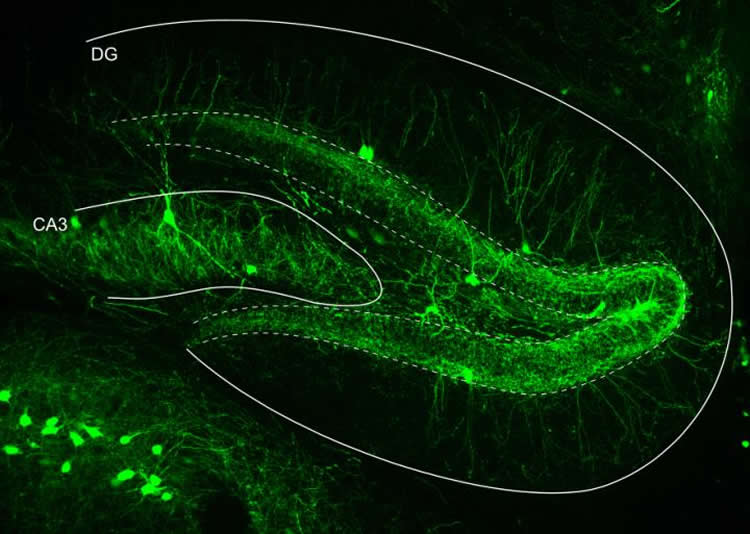Summary: A new Nature Communications study sheds light on how the brain processes information relevant to memory.
Source: University of Freiburg.
The more we know about the billions of nerve cells in the brain, the less their interaction appears spontaneous and random. The harmony underlying the processing of memory contents has been revealed by Prof. Dr. Marlene Bartos and her team. In a study published in Nature Communications, Dr. Bartos highlights the role of inhibiting circuits in the creation of high-frequency brainwaves in the hippocampus. The study helps show how the brain processes information that is relevant to memory.
“Researchers have suspected for a long time that frequencies over 30 Hertz coordinate the synchronous cooperation of various cell networks of the brain. It’s also known that activity in this frequency range is markedly reduced in Alzheimer patients, for example,” says Bartos, summing up the underlying idea of her research.
But how do these signals, known as gamma waves, occur in several places simultaneously? And what does this mean for human memory in real terms?
As experts in the field of synaptic links, Bartos and her team intensively studied the communication between what are called interneurons in the hippocampuses of mice. Situated between two or more other neurons, an interneuron is a cell type with especially short protuberances, which can effect a transmission of inhibiting impulses to its neighboring cells quickly and efficiently.
“Similar to groups of instruments in an orchestra, there are small circuits in which inhibitory interneurons play an important part,” explains Bartos. “You could imagine their role as being like that of the conductor, who makes the horns retreat into the background at points, in order to give them full weight once more the next moment.”
The most important observation of the study was, when they are roused from rest, the surrounding cells are receptive to certain information. Then they are stimulated to develop a common potential for action, so that a signal can be transmitted to other neurons. This in turn can be measured electrophysiologically as a discharge of gamma waves.

“The interesting aspect of this is that the micro-circuits do not interfere with one another, but can store or access various information in parallel, such as the attribute form and color of an object. This allows simultaneous, parallel processing and the storage of information. We believe that this is how the initial traces of memory are laid,” says Bartos.
However, in order really to track down what makes memory, a lot more fundamental research is still required. Bartos and her team are working at top speed to make their findings usable for the treatment of neurodegenerative diseases within a few years.
Funding: This research was supported by the Japan Agency for Medical Research and Development-Core Research for Evolutional Science and Technology (14532135 to S.F.), Japan Agency for Medical Research and Development (145208 and 16770835 to T.H.) and the Cell Science Foundation (K.C). The work was done by University of Freiburg in collaboration with Keio University, Kyoto University, and other institutions.
Source: Marlene Bartos – University of Freiburg
Publisher: Organized by NeuroscienceNews.com.
Image Source: NeuroscienceNews.com image is credited to Marlene Bartos.
Original Research: Full open access research for “Distance-dependent inhibition facilitates focality of gamma oscillations in the dentate gyrus” by Michael Strüber, Jonas-Frederic Sauer, Peter Jonas & Marlene Bartos in Nature Communications. Published online October 2 2017 doi:10.1038/s41467-017-00936-3
[cbtabs][cbtab title=”MLA”]University of Freiburg “The Rhythm of Memory.” NeuroscienceNews. NeuroscienceNews, 24 October 2017.
<https://neurosciencenews.com/memory-rhythm-7795/>.[/cbtab][cbtab title=”APA”]University of Freiburg (2017, October 24). The Rhythm of Memory. NeuroscienceNews. Retrieved October 24, 2017 from https://neurosciencenews.com/memory-rhythm-7795/[/cbtab][cbtab title=”Chicago”]University of Freiburg “The Rhythm of Memory.” https://neurosciencenews.com/memory-rhythm-7795/ (accessed October 24, 2017).[/cbtab][/cbtabs]
Abstract
Distance-dependent inhibition facilitates focality of gamma oscillations in the dentate gyrus
Gamma oscillations (30–150 Hz) in neuronal networks are associated with the processing and recall of information. We measured local field potentials in the dentate gyrus of freely moving mice and found that gamma activity occurs in bursts, which are highly heterogeneous in their spatial extensions, ranging from focal to global coherent events. Synaptic communication among perisomatic-inhibitory interneurons (PIIs) is thought to play an important role in the generation of hippocampal gamma patterns. However, how neuronal circuits can generate synchronous oscillations at different spatial scales is unknown. We analyzed paired recordings in dentate gyrus slices and show that synaptic signaling at interneuron-interneuron synapses is distance dependent. Synaptic strength declines whereas the duration of inhibitory signals increases with axonal distance among interconnected PIIs. Using neuronal network modeling, we show that distance-dependent inhibition generates multiple highly synchronous focal gamma bursts allowing the network to process complex inputs in parallel in flexibly organized neuronal centers.
“Metabolic shift induced by systemic activation of T cells in PD-1-deficient mice perturbs brain monoamines and emotional behavior” by Michio Miyajima, Baihao Zhang, Yuki Sugiura, Kazuhiro Sonomura, Matteo M Guerrini, Yumi Tsutsui, Mikako Maruya, Alexis Vogelzang, Kenji Chamoto, Kurara Honda, Takatoshi Hikida, Satomi Ito, Hongyan Qin, Rikako Sanuki, Keiichiro Suzuki, Takahisa Furukawa, Yasushi Ishihama, Fumihiko Matsuda, Makoto Suematsu, Tasuku Honjo & Sidonia Fagarasan in Nature Immunology. Published online October 24 2017 doi:10.1038/ni.3867






